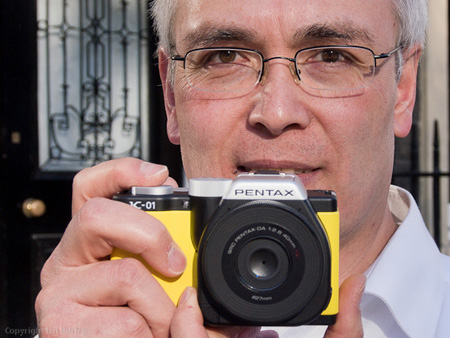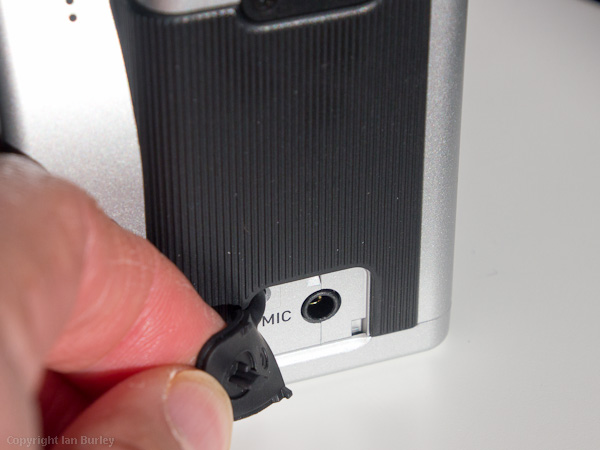Besides backwards K-mount lens compatibility, just what is the point of the Pentax K-01?

Here's the Pentax K-01 in yellow
A day after the official launch of Pentax's new K-01 mirror-less system camera, here are some more pictures and our thoughts on the new camera:
Polarisation
Whether you like the styling or not, the new Pentax K-01 is bold in appearance and will undoubtedly attract attention. But the design strongly polarises opinion, with most being rather bemused by it while a minority of others instantly love it. On the practical side, the omission of an eye-level viewfinder is a big surprise. Pentax and their hired designer, Marc Newson, imply that the camera is a grown up compact and there was never any intention of incorporating a viewfinder. This makes the K-01 either the largest and most sophisticated of point and shoot cameras or the largest and least-sophisticated mirror-less system camera.
Without a reflex mirror the K-01 depends on contrast detect autofocusing. Pentax has developed a new image processing engine to maximise live view and video recording functions, as well as to optimise autofocusing as far as possible. But the most effective optimisation of AF performance for contrast detect systems, by far, is to re-engineer the whole focusing system, software and hardware. By retaining the 37 year old K-mount, Pentax has only done half the job. Pentax might be able to develop new lenses properly optimised for contrast detect AF, but the new 40mm f/2.8 pancake that comes with the K-01 isn't so optimised and its AF performance fitted to the K-01 is, at best, leisurely. It's the same story when focusing with other existing K-AF lenses. Pentax highlights the video functionality of the K-01 and I'm sure both still and video picture quality will be excellent from the new low-power Sony 16MP sensor, but again without proper optimisation for contrast detect AF focusing while recording video will not match that of a properly optimised system.
What benefits does the K-01 offer?
In many ways it's difficult to see what the benefit is of simply removing the optical reflex viewfinder and mirror of a DSLR, which is basically what Pentax has done with the K-01. The camera is not significantly smaller and it's far less flexible than a K-5 DSLR, for example. The K-01 should be cheaper to manufacture as it has much less precision mechanical parts than a DSLR. We don't yet know how the K-01 will be priced. The only obvious benefit is that you can fit almost all K-mount lenses made by Pentax and third parties since 1975. But my question is - is the K-01 really designed to appeal to the kind of photographer that wants to use lots of old K-mount lenses? As far as I can see the K-01 is more of a wannabe style icon that will appeal to certain lifestyle-conscious users and, maybe, some family photographers who like the K-01's unique look.
Here at DPNow we'd like to know what you think - why not let us know on DPNow.com discussion forum?
To round off our preview of the K-01 here are some more pictures taken from London launch event:

The Pentax K-01 fitted with a 35mm f/2.8 macro lens.

And with the 70mm f/2.4 fitted.

And how about a 200mm f/2.8 mounted?

Now, back to the new 40mm pancake lens. The outer-most part of the lens barrel is the manual focus ring. It is permanently engaged and rotates during auto focusing. For this lens auto focus is driven by the in-body AF motor instead of an in-lens motor. Although we only had sample cameras with development firmware, unsurprisingly AF performance was lethargic compared to the new generation of mirror-less cameras that have been designed from the ground up to be mirror-less. The front element of the 40mm pancake is tiny and only requires 27mm filters. This view shows the maximum extension of the lens.

One problem with the pre-production samples we had to handle at the launch was the flimsy nature of the flexible rubber flaps that cover the ports and card slot. It's difficult to re-fit them and the rubber easily catches, often leaving the flap in a state of disarray, like here (above).

Ignore the 'Do not open' notice - this was to prevent journalists from inserting their own memory cards and sneak some unapproved test shots. Below is the USB/audio visual port and a compact HDMI port

A positive point is the inclusion of a port for an external stereo microphone for video work.

The Pentax K-01 uses the same battery as used in the K-5 DSLR.

Here's a view of the K-01's top plate. At the left is a button that releases the pop-up flash unit. There is a dedicated hot shoe behind the pop-up flash, but the mots obvious omission is an eye-level viewfinder, or even the provision for an optional one. The large mode dial features fairly typical settings options. Unusually, there is a mode for in-camera high dynamic range (HDR) shooting. There is one mode adjustment wheel flush with the top surface of the top plate. Next to that is a button for exposure compensation and the green and orange buttons are context-sensitive function buttons.

The back of the K-01 is very conventional. The 3 inch VGA (921,600 dots) LCD screen is very clear and sharp.

The manual/auto focus switch is on the lower left (from the view of the photographer) of the lens mount.

The lens mount lock is on the opposite side and designed to blend in with the mount plinth.

Finally, a closer look at the top-plate.
Reader feedback:
Discuss this story:




